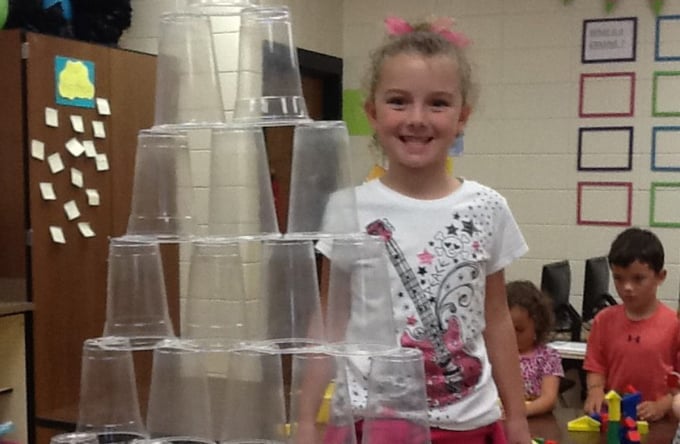Katie Disney teaches at Lakeside Primary in Hot Springs, Arkansas. She is a gifted and talented coordinator and reading specialist with 13 years of experience. In her free time, Katie loves spending time with family.
When I started this PLTW Launch journey, I had no clue how amazing it was going to be. We didn’t know how we were going to implement it in our school or even if we would. But after we went to the training, we were hooked.
The plan was for me to co-teach all of the modules with all of the primary teachers. The reason for this was to have embedded professional development. The teachers could see the module being implemented with their students, and we could have great conversations during staff development about how this would actually look in their classroom.
When I started Structure and Function, the worry was that Kindergarten kids were not going to be able to think in this way, do the writing portion, or figure out how to solve the problems without help. We made a plan to meet each student where they are, but to push them to their fullest potential through questioning.
At first, I saw lots of little nervous faces staring back at me. The teachers saw it, too, and wanted to jump right in and give them the answer to ease their anxiety. This was when I jumped in, instead, and gave them examples of how they are problem solvers. We joked and gave silly examples of ways they would or would not solve a problem. If I said I was hungry, would my mom give me a pencil? No!
Once they started figuring out that there wasn’t a right or wrong and that all of their thoughts were valued, ideas started pouring out of them. Even if they couldn’t write a sentence, they knew they had to put something on the paper to show me their thinking because their thinking was that important.
They had to collaborate in groups and learn to listen to each other’s thinking. The teachers and I would model how to share thoughts, listen to others, and respond appropriately.
I was super-excited about the science portion, but now I saw they were also gaining reading, writing, and social skills. These are skills that will help them for their entire educational career, not to mention life in general. And of course, ALL students exceeded the expectations set for them with a smile on their face.
Parents were emailing, calling, and texting me with examples of how their child was using the vocabulary at home. One parent was excited to hear her 5-year-old talk about how they couldn’t put the Christmas tree up if they didn’t have a wide enough base to support it.
I knew they really got it when I saw it transfer long-term. A group of our students went to a summer camp where they had a sand castle building contest. They got off the bus extremely excited that afternoon because they won the contest. They said they knew they had to start with a wide base to build the tallest and most sturdy sand castle!
The teachers and I were constantly in collaboration about how to question the kids to get them to think more deeply. After all of the teachers completed the module, we met and discussed their experiences. Each of their experiences was different because each of their classes was different, so it was great for them to be able to discuss how they interpreted the modules.
I never imagined that this one thing would open all of these doors. We now are having collaborative conversations that include the parents, students, and teachers and that benefit every child. Although we are just beginning, we are excited to see how this will change the lives of our students.
PLTW’s blog is intended to serve as a forum for ideas and perspectives from across our network. The opinions expressed are those of this guest author.


